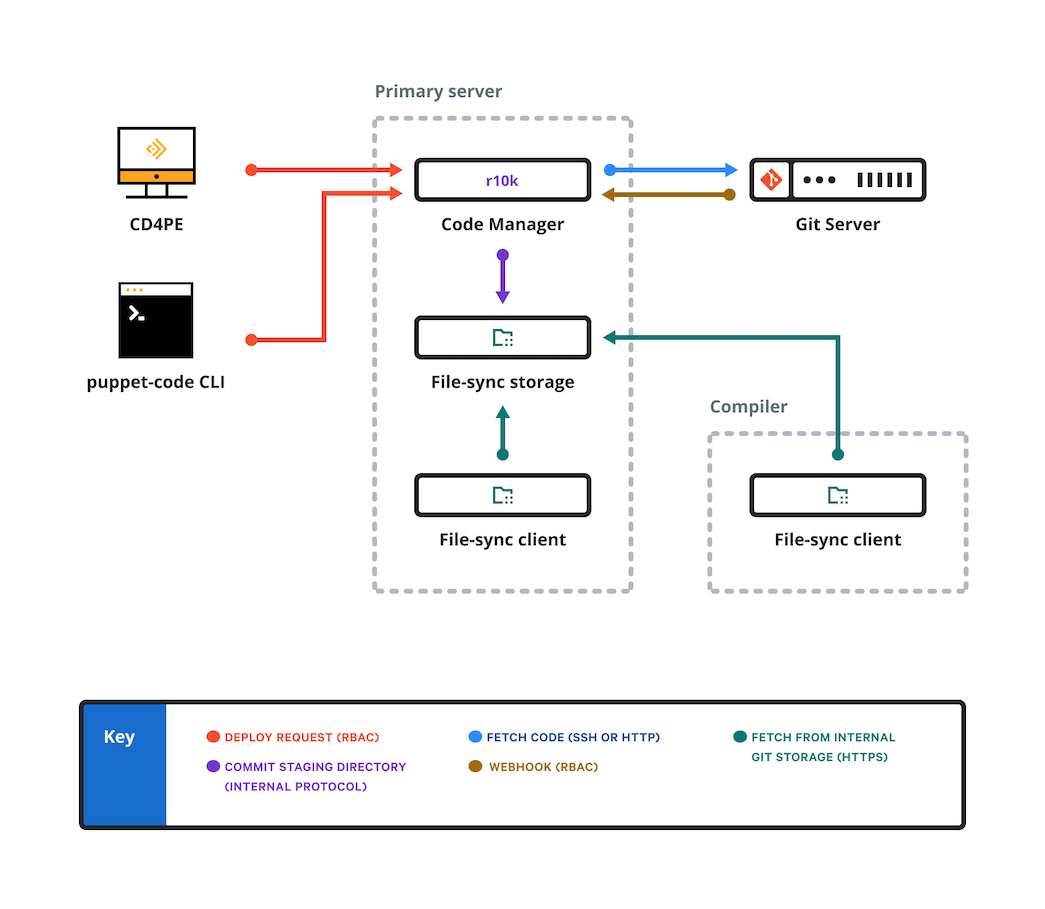How Code Manager works
To automatically manage your environments and modules, Code Manager uses r10k and the file sync service to stage, commit, and sync your code.
Code Manager requires Managing environments with a control repository. You must create a control repository with branches for each environment that you want to create (such as production, development, or testing). Each branch must have a Puppetfile specifying exactly which modules to install in each environment. You can learn more About Environments in the Puppet documentation.
Code Manager creates directory environments based on the branches you've set up. Your control repository lives on a Git server, and this is where you push code that you want Code Manager to deploy.
- A webhook from your Git server automatically starts the code deployment when you push code to the control repo.
- Continuous Delivery for Puppet Enterprise sends a deploy request to Code Manager.
- You use the
puppet-codecommand to manually trigger Code Manager from the command line or with a custom script.
/etc/puppetlabs/code-staging). Next, the file
sync storage service on the primary server detects the change in the staging directory,
and the file sync clients pause Puppet Server to avoid
conflicts during synchronization. Finally, the file sync clients synchronize the new
code to the live code directories on the primary server and compilers (usually at
/etc/puppetlabs/code). The following diagram
illustrates this code deployment process.
Understanding file sync and the staging directory
To sync your code across your primary server and compilers, and to make sure that code stays consistent, Code Manager relies on file sync and two different code directories: the staging directory and the live code directory.
Without Code Manager or file sync, Puppet code lives in the codedir, or live code
directory, at /etc/puppetlabs/code.
With Code Manager and file sync, the file sync client service
regularly checks for changes to staged code files in the staged code directory on the
primary server (at /etc/puppetlabs/code-staging). If it detects a change,
the file sync client service fetches the changes and syncs the files to the live codedir on
each compiler and the primary server (at /etc/puppetlabs/code). The file sync client service uses HTTPS to poll for
changes and JGit to fetch changes.
Environment isolation metadata and Code Manager
The live code and staging code directories contain metadata files generated by file sync, which provide environment isolation for your resource types.
.pp extension, ensure that each
environment uses the correct version of the resource type. These files are generated when Code Manager deploys new code in your environments. If you are new to Code Manager, these files are generated when you first deploy your environments. If you already use Code Manager, the files are generated as you make and deploy changes to your existing environments.
You can learn more about these files and their role in Environment isolation in the Puppet documentation.
Moving from r10k to Code Manager
Moving from r10k to Code Manager can improve automation of your code management and deployments.
While we recommend using Code Manager whenever possible, reasons you might not want to upgrade from r10k to Code Manager include:
-
Code Manager
does not allow you to manually deploy code with r10k. If you depend on the ability to deploy modules
directly from r10k (with the
r10k deploy modulecommand), we recommend continuing to use r10k. - Code Manager must deploy all control repositories to the same directory. If you use r10k to deploy control repositories to different directories, we recommend continuing to use r10k.
- Code Manager supports the shellgit provider, but only for HTTPS. It does not support system .SSH configuration or other shellgit options.
- Code Manager does not support post-deploy scripts.
If you rely on any of the above configurations Code Manager does not support, or if you are using a custom script to deploy code, carefully assess whether or not Code Manager can support your goals.